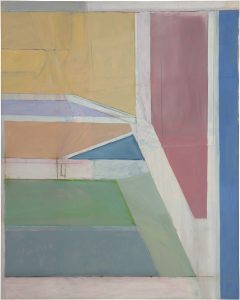ARTnews: “A New Kind of Spatial Understanding”: Jane Livingston on Richard Diebenkorn at a Pivotal Moment of Transition
An excerpt from the new catalogue raisonné of the artist’s work
October 22, 2016

More than 20 years after his death, in 1993, at the age of 70, artist Richard Diebenkorn is in the spotlight. This week the Baltimore Museum of Art opens “Matisse/Diebenkorn,” an exhibition of more than 90 works by the two figures that looks at the French master’s influence on the Californian painter. In March the show will travel to the San Francisco Museum of Modern Art in an expanded form. Today Yale University Press releases the artist’s catalogue raisonné, a full accounting of his work, years in the making, replete with reproductions of little-known pieces. It has been edited by scholars Jane Livingston, who co-curated the artist’s 1997 retrospective at the Whitney Museum in New York, and Andrea Liguori, the managing director of the Richard Diebenkorn Foundation. Below, an excerpt of an essay from the catalogue by Livingston, in which she precisely examines two works by Diebenkorn, the painting Ocean Park #27 (1970) and the drawing Untitled #15 (1970), both made at a moment when the artist was working in Santa Monica, California, and guiding his astonishing language into new and venturesome abstract realms. —The Editors
In 1966 Richard and Phyllis Diebenkorn moved from Berkeley to Santa Monica, a move that coincided with the end of their child-accompanied years. Diebenkorn had accepted a position on the art faculty of UCLA, whose department director, Frederick Wight, promised that his administrative duties would be minimal, and his relation to studio artist pupils, open-ended. (This promise proved to be unfulfilled; Diebenkorn would be embroiled in far more faculty and administrative issues than he’d bargained for.) For the first few months the couple rented a relatively modest bungalow near the ocean while they looked for a more permanent residence. (See the artist’s rendition of this house in cat. 3902.) They soon found a congenial Mediterranean-style house on Amalfi Drive in Santa Monica, in a canyon fairly close to the sea, and convenient to the UCLA campus. They would live there for twenty-one years.